|
|
 |
|
|
6th South African Armoured Division (Part 2)
|
Crossing the Trasimene Line
By 28 June 1944, after heavy fighting on the
Trasimene Line had broken German resistance, the Allies streamed North
with the 24th Guards Brigade reaching Chianciano and the 11th Armoured
Brigade pushing North of Lake Montepulciano.
The British Eighth Army’s XIII Corps advance on
Florence led by the British 6th Armoured Division on the right, British
4th Infantry Division in the centre and the 6th South African Armoured
Division on the left. The Division advanced in two columns through
Rapolano and Palazzuolo until they encountered the LXXVI Panzer Corps on
the Georg Line, a delaying position on the north side of Route 73.
The strength of the panzerkorps was not known initially and the leading elements of British XIII Corps continued to probe forward expecting the German line to crumble under pressure without the need to launch a full-scale attack. The corps fed in more battalions in an attempt to secure the Monte Lignano high ground and fighting for the hill continued on 6 and 7 July 1944, but the German 15. Panzergrenadierdivision continued to hold the heights. The 6th South African Armoured Division had been stopped on the left flank with the two Infantry Brigades spread over a 10-mile (16 km) front, and the armour had been withdrawn into reserve because of the difficult terrain.
|
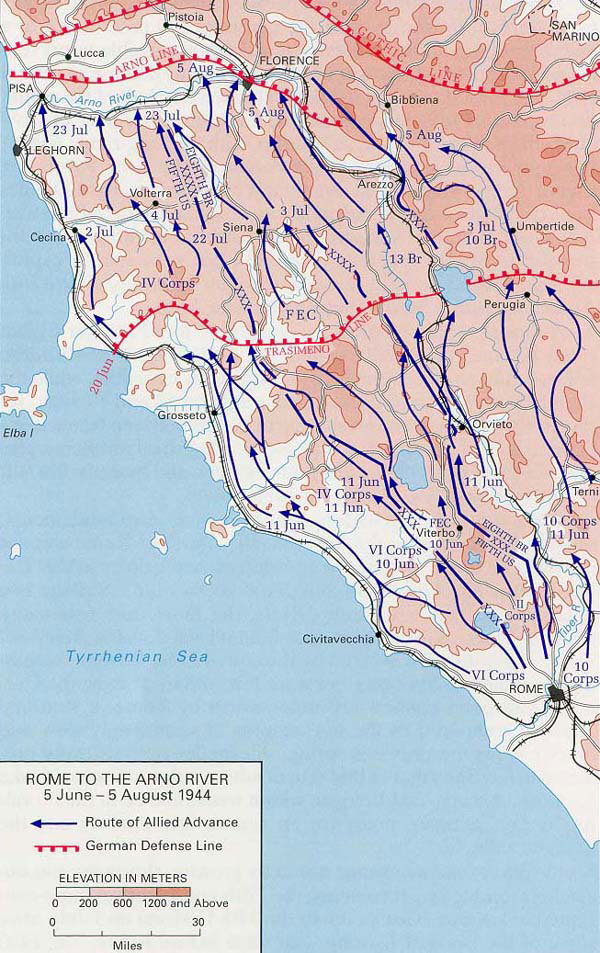 |
|
On 7 July 1944, the 2nd New Zealand Division was
brought forward from the reserves and their attack together with the
British 6th Armoured Division eventually took the high ground and caused
the German Corps to withdraw towards the Heinrich Line behind the River
Arno on 15 July 1944. The 6th South African Armoured Division then
continued their advance, directed on an axis towards Radda-Greve on the
western side of the Chianti Mountains covering the southern approaches
to Florence.
The 6th South African Armoured Division made good progress, advancing with two Brigades leading the advance, the 12th Motorised Brigade astride the road defining the division’s axis of advance and the 24th Guards Brigade on the right flank, on the slopes of the Chianti highlands. Radda was secured on the night of 17 July 1944 and orders were then received for the 6th South African Armoured Division to secure the heights of the Chianti Highlands. The 24th Guards Brigade took Mount Maione by a night attack on the night of 18/19 July 1944 supported by the tanks of the PR while 12th Motorised Brigade attacked to take Mt. St. Michele on 20 July 1944. The 6th South African Armoured Division now held the heights of the Chianti range, dominating the Arno Valley and the advances to Florence.
|
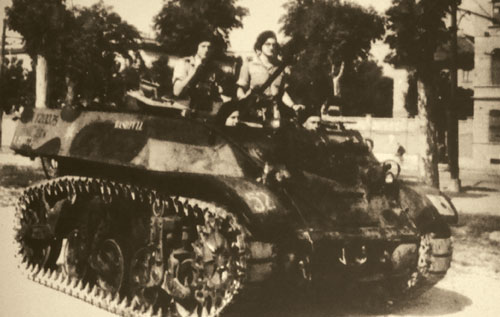 |
Florence
On 20 July, Gen. Sir S.C. Kirkman, the British XIII Corps Commander, issued orders for a “Powerful thrust to seize all crossings across the River Arno to the west of Florence”. This effort was to be concentrated on the 6th South African Armoured Division front. The advance was to be led by the 6th South African Armoured Division with the US 4th Infantry Division to its right, supported on the flanks by the British 6th Armoured Division and 8th Indian Division.
|
|
The 6th South African Armoured Division advance
was slowed at the approaches to Greve due to heavy mining, where a
number of tanks were lost, but eventually the 11th Armoured Brigade
succeeded in capturing Mercatale, which was defended by the German 356.
Infanteriedivision supported by Tiger I E tanks. The 6th South African
Armoured Division advanced through Greve and were again stopped by the
German 4. Fallschirmjägerdivision on the River Greve on 24 July 1944.
However, the 6th South African Armoured Division had out-flanked the
German 4. Fallschirmjägerdivision who then withdrew during the night of
24/25 July 1944 allowing the South African, New Zealand and Indian
divisions to advance to the Paula Line, which was reached on 28 July
1944.
Gen. Sir S.C. Kirkman again placed the South African and New Zealand divisions as the spearhead of his Corps advance, this time to break the Paula Line and to take Florence. The New Zealand Division would carry out the main assault and the South African Division would neutralize the enemy on the high ground west of Impruneta and then clear Route 2 into Florence. The attack was scheduled for 30 July 1944. Field Marshal H.R.L.G. Alexander, 1st Earl Alexander of Tunis, Commander of Allied Armies in Italy, had indicated that he had no intention of fighting in Florence and so Gen. Sir S.C. Kirkman gave orders to by-passing of the city.
|
|
On 31 July 1944, the heavy artillery support for the attack had resulted in an ammunition shortage and Gen. Sir S.C. Kirkman ordered a 24-hour pause for fresh supplies to arrive. The Desert Air Force flew over 100 sorties per day on 31 July and 1 August 1944 in support of the attack and by 3 August 1944 columns of South African, New Zealand and British 4th Infantry divisions were advancing towards Florence. By 4 August 1944, advance parties were exploring the outskirts of Florence to find that all Bridges across the Arno River viable for military transport had been destroyed.
An ILH/KimR patrol however found the smaller Ponte Vecchio bridge intact and crossed it under heavy shelling, entering into the centre of the city at 04:00, to be the first Allied troops to enter Florence.
|
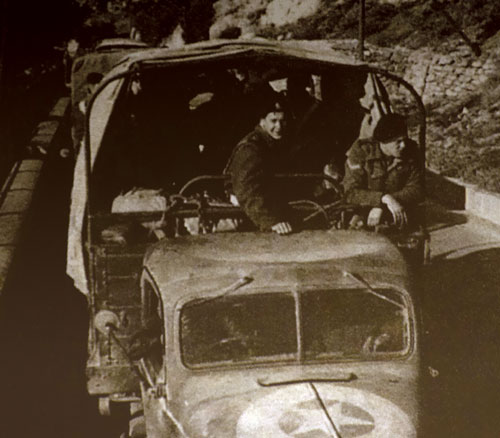 |
|
After reaching Florence, Maj. Gen. W.H.E. Poole recorded in a Special Order of the Day, that the 6th South African Armoured Division had “Covered 601 miles (967 km) since leaving its concentration area at Taranto, its artillery had fired 201,500 rounds, the divisional engineers had built 65 bridges and had made 196 major deviations necessitated by ‘blows’ and demolitions. The signallers had laid 3,752 miles (6,038 km) of telephone cable”.
The 6th South African Armoured Division was then withdrawn into British Eighth Army reserve for rest and maintenance in the Siena /Castelnuovo area on 6 August 1944 until 17 August 1944, when orders were issued for the 6th South African Armoured Division to be transferred from British XIII Corps to US IV Corps to partially replace divisions withdrawn to the US Seventh Army for the assault of southern France. The 6th South African Armoured Division was assigned to their new Corps in the US Fifth Army on 22 August 1944. The role of the US Fifth Army was to distract the enemy by intensive patrolling during the days preceding the British Eighth Army attack, and then to launch an offensive in the Florence area. The main effort was to be made by US II Corps astride Highway 65, in the direction of Bologna. US IV Corps was to hold the sector along the Arno to within 5 miles of Florence, and was to protect the left flank of US II Corps during its advance into the Appenines.
|
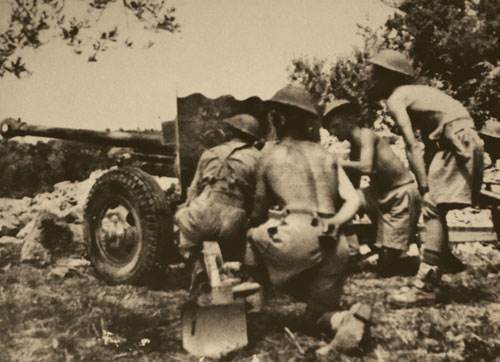 |
Advance on the Appenines
To continue the main Allied thrust north from Florence, the Arno River first had to be crossed. On 21 August 1944 an order announced that the 6th South African Armoured Division would pass under command of US IV Corps with effect from the following day, and would relieve the 85th US Division west of Florence. The relief of the Americans commenced on the night of 24 August 1944 and was completed on 26 August 1944.
|
|
The relief went smoothly although the 59th South
African “Q” Company was bombed by eight enemy aircraft on the afternoon
of 24 August 1944, and 21 PR tanks broke down on the road, because the
rest period was too short to allow overhaul to be completed.
The 6th South African Armoured Division took over a front of over 20 miles along the south bank of the Arno, west of Florence. The 12th South African Motorised Brigade, with Prince Alfred’s Guard (PAG) under command, held the eastern sector and the 24th Guards Brigade with Pretoria Regiment (PR) under command, the western sector. The 11th Armoured Brigade was in reserve. The 74th British Light Anti-Aircraft Regiment (now converted into an Infantry Battalion) was under command of the 12th South African Motorised Brigade, while the 166th NFLD (Newfoundland) Field Regiment, Royal Artillery, which had just joined the 6th South African Armoured Division, supported the 24th Guards Brigade.
|
The 6th South African Armoured Division was rather thin on the ground, but the artillery and the Royal Durban Light Infantry (RDLI) did their best to cover the wide front. The 6th South African Armoured Division’s signal squadrons had to lay some 1500 miles of cable. It was noted that the German 3. Panzergrenadierdivision was on the eastern sector as far as Empoli, and thereafter 26. Panzerdivision continued the front. Partisans frequently crossed the river and gave valuable information. It was impossible on such an extended front to watch the entire watercourse, and German patrols often infiltrated into the lines. The ration jeep and Company Quartermaster-sergeant of the RNC (Royal Natal Carbineers) were shot up, and the same night a strange voice rang through on the telephone and with unrewarded optimism asked the Witwatersrand/De La Rey Regiment (WR/DLR) for the password for the night. The vigorous patrolling of the 6th South African Armoured Division soon curtailed the German’s activities South of the river.
|
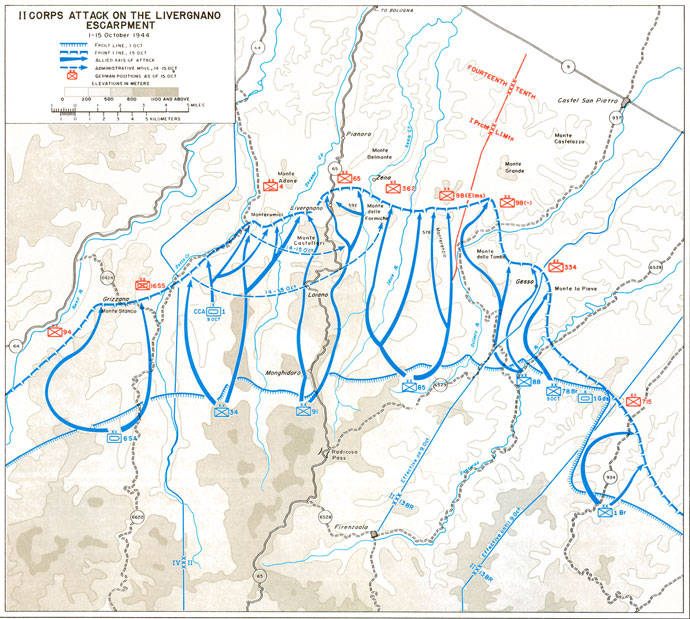 |
The Arno was first crossed on the night of 26/27 August 1944 by a patrol from First City/Cape Town Highlanders Regiment (FC/CTH). Reconnaissance patrols from the FC/CTH found suitable crossing points close to Le Piagge allowing the 12th South African Motorised Brigade to cross during the night of 28/29 August 1944 under light enemy artillery and mortar fire. The German observers took full advantage of the commanding ground on the southern spurs of Mt. Albano. The Germans also used new rocket launchers whose projectiles had considerable blast effect, which also announced their coming with an unpleasant screaming noise. Reports from prisoners indicated that the German forces in front of the 6th South African Armoured Division were withdrawing and this was confirmed by the sound of demolitions ahead of them. The 12th South African Motorised Brigade, as well as the 24th Guards Brigade was tasked to send fighting patrols forward to determine the extent of the withdrawal.
|
On the night of 31 August/1 September 1944 both the RNC and FC/CTH secured footholds on the northern bank, and just west of Empoli the 3rd Battalion, The Coldstream Guards did the same. Apart from some machine-gun and mortar fire, and a patrol clash on the Guards front the crossing was unresisted. Reports indicated that the Germans had withdrawn across a wide front to what was to later known as the Gothic Line. The 6th South African Armoured Division crossed the Arno river, thanks to Bailey bridges erected between the damaged abutments by the South African Engineers on 1 September 1944 and pushed into the Albano hills overlooking the river.
|
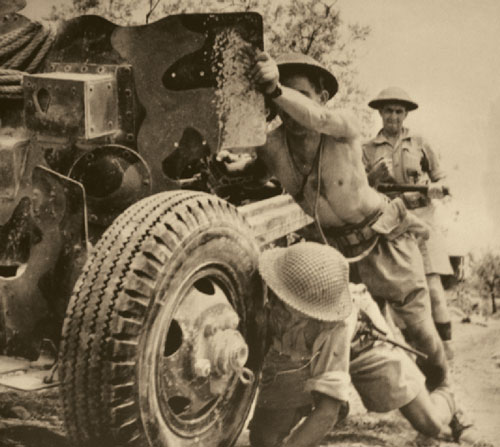 |
|
By the afternoon of 1 September 1944, “C” Company, RNC reached Arlimino, while the 24th Guards Brigade had secured a substantial bridgehead. The Germans had sown the river bank with mines, and the 24th Guards Brigade reported the thickest minefield which they had yet encountered. Three bulldozers were lost in 24 hours. By 2 September 1944, the PAG was able to get their tanks across the river, and rapid progress was made in the divisional task, which was to occupy Mt. Albano.
The operation was completed by 3 September 1944. The only impediments to the advance were a tremendous flood which washed away the bridge at Empoli on 6 September 1944 and delayed the crossing of 11th South African Armoured Brigade, and the orders of US IV Corps, which laid down where the front line should run each day, regardless of the opposition or lack of opposition offered by the enemy. The Germans made no attempt to hold Mt. Albano, and a foot patrol of the RNC reached the outskirts of Pistoia on 6 September 1944. The RNC entered the town without opposition on 8 September 1944 and the 11th South African Armoured Brigade was brought into the line on 10 September 1944.
|
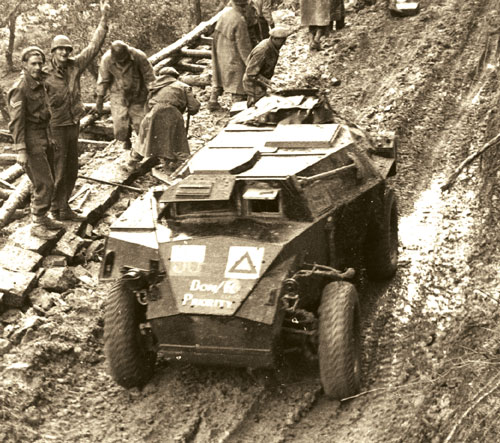 |
On 11 September 1944, the 6th South African Armoured Division regrouped with the 11th South African Armoured Brigade on the right, the 12th South African Motorised Brigade in the centre, and the 24th Guards Brigade on the left. The 6th South African Armoured Division was ordered to advance and occupy the general line of Northing 91, running some 2 miles north of Pistoia. Maj. Gen. W.H.E. Poole observing the lack of resistance ahead of the 6th South African Armoured Division, encouraged a rapid advance, but this was countermanded in order not to compromise the surprise of the main US Fifth Army attack north of Florence. The order to wait and hold the Albano Massif until further notice was deeply resented by the 6th South African Armoured Division’s command and was considered representative of the persistent inflexibility displayed by the US Fifth Army leadership.
|
|
Apennines
The British Eighth Army offensive on the German held Gothic Line was codenamed “Olive” and commenced on 25 August 1944. Ultra intercepts had shown that the Allies had a significant numerical superiority in manpower, armour, air and artillery, although there were concerns regarding the relative inferiority of Allied tank armour and gun power as compared to German equipment. The US Fifth Army attack was launched on 10 September 1944 against the mountain bastions south of Bologna and the main assault of the Gothic Line was to be delivered by the US II Corps up the Futa Pass, on the main highway between Florence and Bologna. In conformity with this move, 6th South African Armoured Division as the right flanking formation of the US IV Corps, had been ordered to push into the hills north of Pistoia. The right boundary of the 6th South African Armoured Division was the Prato - Bologna road and the Western boundary ran North and South through a point a mile west of Montecatini.
|
As part of the plan, the 6th South African Armoured Division was ordered to advance along Route 64 leading to Vertago and Bologna and to capture the twin peaks of Sole and Capara. The 6th South African Armoured Division’s 24th Guards Brigade were first to encounter the Gothic Line defences when the 24th Guards Brigade met strong resistance from two battalions of the Lehr Brigade as well as two battalions of 362. Infantriedivision, fighting from strongly fortified positions which had been prepared throughout the previous winter.
|
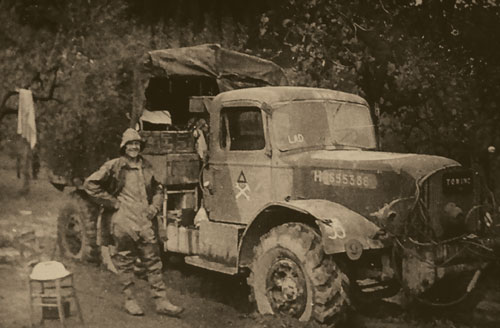 |
|
On the morning of 11 September 1944, a patrol of the Scots Guards patrolling towards Femina Morta found the place held by the Germans and protected a thick belt of wire. The 6th South African Armoured Division had reached an outpost of the Gothic Line. On 12 September 1944, forward movement into the Appenine foothills met increasing shellfire and patrols began to clash with German ground troops. On 13 September 1944, the US II Corps opened its great attack on the Futa Pass and good progress was made. The policy for US IV Corps was to continue aggressive patrolling, and maintain contact with the Germans. The 6th South African Armoured Division was ordered to occupy the high ground between the roads Pistoia-Poretta and Prato-Castiglione.
Enemy resistance stiffened and there were fierce actions at Mt. Alto which was captured by the 4/13th Frontier Force Rifles Brigade, who were specially trained in mountain warfare, and at Mt. Porro Del Bagno, which was stormed by the ILH/KimR on 18 September 1944. German shellfire was heavy and the 4/13th Frontier Rifles Brigade had to advance along a narrow ridge commanded by Spandau posts. These were cleared one by one, and after some close fighting on the bush covered crest of Mt. Alto, the 4/13th Frontier Rifles Brigade gained their objective. They were heavily counter-attacked on 18 September 1944, and ammunition ran out. Mules bringing up more ammunition were dispersed by shellfire, but the 4/13th Frontier Rifles Brigade used their bayonets and clung to the mountain.
|
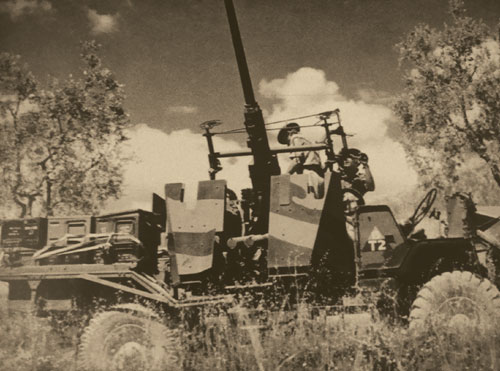 |
Meanwhile the ILH/KimR was involved in sharp fighting on Mt. Porro Del Bagno. After a clash with the enemy, commanding group was captured by “A” Company, ILH/KimR on the afternoon of 16 September 1944. On 17 September 1944, “C” Company, ILH/KimR made a flank attack but the enemy held a dominating position on the thickly wooded mountain, and were driven back. Tanks of “A” Squadron, SSB attempted to give support but could not force a way through the brushwood. On the morning of 18 September 1944, two tanks succeeded in getting into the “A” Company, ILH/KimR area, and fired with effect on an enemy observation post.
|
|
At 18:00 “A” Company, ILH/KimR attacked in the
gathering dusk, supported by direct fire from the tanks, and a barrage
was put down by the 1/6 Field Regiment, SAA and 4/22 Field Regiment,
SAA. The attack was completely successful and the enemy’s use of tracer
on a fixed line was much to the advantage of the attacking troops.
Meanwhile “A” Company, ILH/KimR captured a spur on the south west of the
mountain. The whole ILH/KimR area was heavily shelled during the three
days battle for Porro Del Bagno. The capture of Mt. Alto and Mt. Porro
Del Bagno did much to deprive the enemy of observation over the
divisional area.
Then after being ordered to hold the Albano Massif, the 11th South African Armoured Brigade was forced due to the terrain to operate dismounted from their tanks in order to contain the German 362. Infanteriedivision. By 22 September 1944, demolitions were again heard and it became evident that the Germans had started withdrawing to Green Line II, the next layer of the Gothic Line defences. Operation “Olive” officially ended on 21 September 1944.
|
|
South African Units
RDLI - Royal Durban Light Infantry
NMR - Natal Mounted Rifles
DROR - Duke of Edinburgh’s Own Rifles
RLI - Rand Light Infantry
RB/RPS - Regiment Botha/Regiment President Steyn
PR - Pretoria Regiment
PAG - Prince Alfred’s Guard
SSB - Special Service Battalion
ILH/KimR - Imperial Light Horse/Kimberley Regiment
RNC - Royal Natal Carbineers
FC/CTH - First City/Cape Town Highlanders Regiment
WR/DLR - Witwatersrand/De La Rey Regiment
|
|
Last Updated On Thursday, April 17, 2014 by Wayne at Battlefront
|
|
|